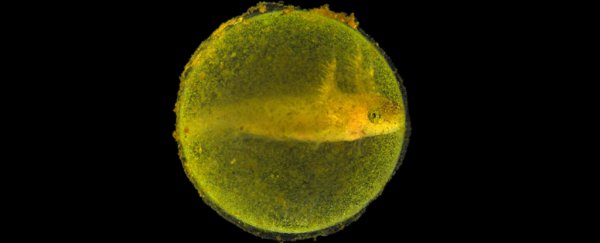Back in 2011, scientists discovered the world's only known example of a vertebrate cell hosting the cells of a completely different species in an act of symbiosis between a salamander and a species of algae.
While similar relationships can be found in animals without a backbone, such as coral and molluscs, this unusual discovery posed a bunch of questions about how the partnership is even possible in a vertebrate, and who it's benefiting. Now, thanks to a new study, we're starting to get some answers - and it's not pretty.
Researchers from the American Museum of Natural History in New York and the Gettysburg College in Pennsylvania analysed the genes of a green alga and a species of spotted salamander called Ambystoma maculatum, with which it forms a rather intimate relationship.
The alga's scientific name, Oophila amblystomatis, is the perfect introduction to this unicellular life form, translating roughly as "Ambystoma egg lover."
For over a century, biologists have marvelled at how the alga slips inside the envelope surrounding the salamander's eggs and cosies up to them.
On the surface, it looks like a textbook example of a type of symbiosis called mutualism, it's a win-win for both parties – the algae get to feed off the carbon and nitrogen compounds seeping from the eggs as waste, while the growing salamander gets a steady supply of oxygen released by their photosynthesising neighbour.
But fast-forward to 2011, and researchers from the US and Canada found that this interesting relationship crossed a rather unique boundary, with algae discovered growing inside the cells of the developing salamanders, making it an act of endosymbiosis.
While you don't need to look very far to find examples of vertebrates growing algae on their outsides (do we ever need an excuse to look at a sloth?), finding a species of alga growing inside a vertebrate's cells is pretty rare.
How rare? This is a world first.
Algae living inside the cells of non-vertebrate animals isn't all that odd; after all, coral cells are home to a brown-yellow algae called zooxanthellae, while the cells of the green sea slug Elysia chlorotica don't just kidnap innocent algae, they steal their genes.
Microbes also occasionally gobble up one another to share each other's talents. In fact, our complex cells are thought to be the result of such an event that occurred over a billion years ago between a type of microscopic organism called an archaea and a bacterium.
But none of those animals have backbones, which makes the relationship between the salamander and the alga a really odd example.
Vertebrates tend to have immune systems that adapt to invading materials, and make it hard for another organism to get a toe inside their cells. So scientists weren't quite sure how this relationship was even possible.
Thanks to this latest research, we now have a better idea of what's going on at a chemical level between the cells of the algae and those of this remarkable amphibian. And it's pretty weird.
The scientists mapped the complete library of messenger RNA codes transcribed from the genes of algae growing outside of the eggs and compared it with those growing inside the cells.
While the algae make good use of their bath of salamander filth and ample light to produce oxygen and sugar outside of the eggs, inside the cell, it's a whole different story.
The algae might be photosynthetic, but they still benefit from having plenty of oxygen in their environment. As you might assume, things are a little stuffy inside the salamander's cells, leaving the algae "gasping for air".
"Unlike the alga in the coral-alga symbiosis, the alga in this interaction is stressed, and rather than producing oxygen and sugar through photosynthesis, it is fermenting," John Burns from the American Museum of Natural History told George Dvorsky at Gizmodo.
"This suggests that the alga is in a relatively low oxygen environment."
In addition to switching to fermentation as a way to deal with the limited oxygen supply, the products of the alga's genes revealed other signs of stress, including the making of proteins that usually appear in response to heat stress or being swallowed up by a predator.
On the other hand, on examining the genes being activated in the salamander, the researchers found it was hardly bothered by the intruder.
In fact, it appeared to tune its immune system to ignore its 'guests'.
By the same token, there was no clear indication of any benefits to the salamander either, leaving a rather perplexing mystery; why on Earth would it bother kidnapping this alga in the first place?
It's possible the algae could still be providing some small benefit to the salamander, which the researchers claim could be supported by previous research.
"We may speculate that intracellular algae are providing some benefit to its host, as many past light/dark rearing experiments have shown a net benefit to the salamander embryo from their algal symbionts, which presumably included endosymbionts as well," they write in their report.
If they are getting something from the algae in their cells, it's not much gain for a whole lot of pain for their microscopic prisoner.
The algae could also provide some sort of benefit to the salamander's immune system, a feature found in other forms of endosymbiotic relationship.
There is also the exciting question of whether or not the alga is passed on to the next generation inside replicating sex cells - something researchers have yet to discover.
Clearly a study that began as a curiosity over a century ago still has plenty more secrets to give up.
This research was published in eLife.
